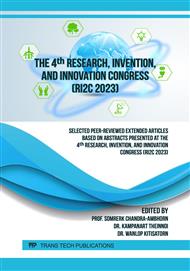p.87
p.97
p.103
p.111
p.121
p.131
p.139
p.155
p.163
Enhancing the Performance of Soil-Cement Pavement through Modified Natural Rubber Latex with Coumarone-Indene Resin
Abstract:
This research focuses on the modification of Natural Rubber Latex (NRL) for its application in soil-cement pavement. The NRL was modified with Coumarone-Indene (CI) and various tests were conducted to evaluate the effects of this modification. The degree of swelling test showed that the NRL's ability to absorb and retain toluene solvent was influenced by the addition of CI. The tensile tests revealed that the inclusion of CI improved the tensile modulus and tensile strength of the NRL up to an optimal content, beyond which there was a decrease. Peel strength tests demonstrated that the incorporation of CI initially increased peel strength up to an optimal CI content, after which it decreased. The splitting tensile test and the unconfined compressive test indicated that soil-cement blends containing modified NRL with CI 8 phr exhibited higher splitting tensile strength and unconfined compressive strength compared to those with neat NRL. Overall, the modification of NRL with CI showed promise in enhancing the properties of soil-cement pavement materials. The findings contribute to the understanding of modifying NRL for pavement applications and provide insights for further research and development in this field.
Info:
Periodical:
Pages:
155-161
Citation:
Online since:
October 2023
Authors:
Keywords:
Price:
Сopyright:
© 2023 Trans Tech Publications Ltd. All Rights Reserved
Share:
Citation:



